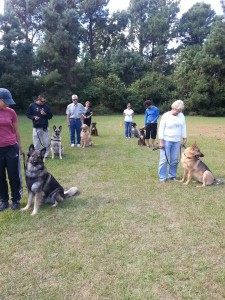 The Structure of Group Programs at Greater Coastal Canine Academy
The Structure of Group Programs at Greater Coastal Canine Academy
It is our belief that group environments should be well structured, have enough trainers per class, and more importantly be utilized as part of a continuing learning process.
Often times the dynamics of a group class are not necessarily conducive to learning. Years of experience and research have brought us to this conclusion: we knew we needed to develop our own approach. From this we gained knowledge, not only in obedience training, but behavioral work as well. During this time we chose to emphasize on the Learning Dynamics of Group vs Private Training” Years past has included teaching both private and group students. Yet, we were more convinced that the group dynamics was a better proofing stage after students had an understanding of how to work with their learned obedience from private lessons.
If a dog trainer’s job is to teach both the human and canine, what was the best environment to accomplish this? It was not until we got involved in Schutzhund training years ago that we really began learning about dog training as a whole. Although Schutzhund (Protection Dog) in German has been geared over the years towards the German 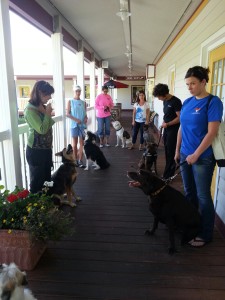 shepherd, the principles of the training can be applied to not only advanced training, but simple manners as well. In a nutshell, our Schutzhund experience provided us with the most crucial factor that must apply to any dog training protocol; the importance of focus. Once we came to this conclusion, the question asked; “Can reliable focus be taught in a group environment?” The answer from experience is no. Our conclusion is based on the dynamics of dog behavior, and how a dog learns. Upon entering a group environment without any prior training, a dog instinctively wants to go sniff, and explore members of their own species. This is normal dog behavior. Without training, the human at this point will start to pull and yank on their dogs. Verbal commands, such as leave it, sit or come are used, and the dogs are still in an over stimulated state pulling as hard as they can to get to the other dogs, ignoring anything their human is saying. Bribery is than offered, and misunderstood by the dog.
shepherd, the principles of the training can be applied to not only advanced training, but simple manners as well. In a nutshell, our Schutzhund experience provided us with the most crucial factor that must apply to any dog training protocol; the importance of focus. Once we came to this conclusion, the question asked; “Can reliable focus be taught in a group environment?” The answer from experience is no. Our conclusion is based on the dynamics of dog behavior, and how a dog learns. Upon entering a group environment without any prior training, a dog instinctively wants to go sniff, and explore members of their own species. This is normal dog behavior. Without training, the human at this point will start to pull and yank on their dogs. Verbal commands, such as leave it, sit or come are used, and the dogs are still in an over stimulated state pulling as hard as they can to get to the other dogs, ignoring anything their human is saying. Bribery is than offered, and misunderstood by the dog.
From correcting the dogs with a leash jerk, to spending the first half hour of an hour class waiting for the dogs to calm down. Needless to say the frustration of the humans fueled more chaos in the dogs. By the second half hour of the class, the dogs were no more interested in their humans than the man on the moon. Even the yummiest of treats proved futile. The environment of the Schutzhund training proved to be the most effective approach. In the learning phase of training each dog and human first received individual lessons. No distraction at this 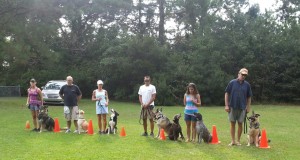 point. The emphasis was to create the behavior; focus, or teaching the dog that paying attention to the human was going to gain them a positive end result; either a treat or a ball. We both agreed and enjoy watching the success in dogs having the opportunity to learn this way.
point. The emphasis was to create the behavior; focus, or teaching the dog that paying attention to the human was going to gain them a positive end result; either a treat or a ball. We both agreed and enjoy watching the success in dogs having the opportunity to learn this way.
Without yanking or jerking, each dog has a fair chance at learning what was expected of him or her. Once the behavior was created; another dog would be brought to the training area. Now the dog had to perform the task with the distraction of another dog. Did it work? Yes it did, over and over again. Success was gained in allowing the dog to learn without constantly having his or her air supply cut off by a leash jerk.
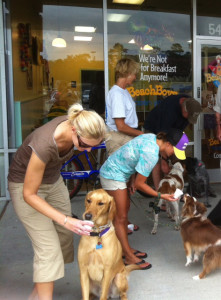 Now, every Schutzhund trainer naturally had their own approach, some more compulsive than others. This was a learning experience in and of itself. However, we took the path from those trainers that first allowed the dogs to learn. Meaning, never correcting a dog for not knowing!
Now, every Schutzhund trainer naturally had their own approach, some more compulsive than others. This was a learning experience in and of itself. However, we took the path from those trainers that first allowed the dogs to learn. Meaning, never correcting a dog for not knowing!
Upon entering a group environment with no training, each leash jerk is a correction, or an anticipation of something not being right. This in our experience and does not allow for a positive learning environment. If the beginning of a puppy’s life is imprinted properly, by setting the stage to learn what is expected fairly, than, each dog has a better chance at having a forever home.
We conclude with this statement because our experience has led us here. We have worked with far too many dogs that have been through group training classes in the beginning and finished with aggression issues, or severe fear based behaviors, simply from constantly being jerked on a leash. Often times the owner’s have had to give these dogs up because they became too much to handle.
 Now we know that this last statement sounds a bit dramatic. But it’s true, although maybe not applicable to all group training environments. The right group class is small, with more than one trainer. The group is set that each trainer should be working with no more than 2 or 3 students, after the head trainer demonstrates what will be covered in class. The initial meeting should be an orientation without the dogs being present. The structure and agenda should be addressed; and a demo dog should be present to show the students how to begin training: FOCUS!
Now we know that this last statement sounds a bit dramatic. But it’s true, although maybe not applicable to all group training environments. The right group class is small, with more than one trainer. The group is set that each trainer should be working with no more than 2 or 3 students, after the head trainer demonstrates what will be covered in class. The initial meeting should be an orientation without the dogs being present. The structure and agenda should be addressed; and a demo dog should be present to show the students how to begin training: FOCUS!
This gives all the students an opportunity to get a head start on this command/behavior, prior to the first class. All of our group classes follow this protocol. From beginning to advanced.
We offer a Shared Lesson program to students that have been through private lessons, and want to start working with another dog prior to going into a full group class.
We offer a host of group training environments, from the Canine Good Citizen to Beach Bound Hounds.
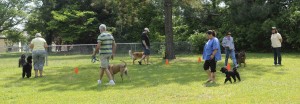
Recent Comments